Posts Tagged ‘after hair transplant’
Wednesday, December 16th, 2009
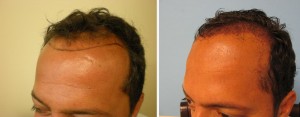 Before and After Pictures; First Day After Hair Transplant Well, on the first day we’re usually forced to kick out our patients from our office because they grow so fond of us and don’t want to leave! Well, not all the time. But our patients do like us, which is something we’re very proud of.
On a more serious note, I’ll say this: Transplanting hair is a very delicate and painstaking procedure. After a hair transplant is over, it is of utmost importance to constantly monitor and properly care for the transplanted area. US Hair Transplant’s policy is to book a patient for a hair washing the day after his or her transplant. The hair washing takes about half an hour. At our office, we use thick shampoo to clean the transplanted hair grafts. We make sure to be gentle and only spread foam and dab the transplanted area. After two minutes, we rinse off the shampoo with water.
During the first visit, another area we wash is the donor area. As a parting gift, we provide our patients with a sponge, which has a soft brush on one side. The brush is used to clean the donor area and the sponge for the transplanted area. When it comes to washing the donor area, a patient may use a bit of aggression as the wounds are stapled or sutured. The soft brush can be rubbed, ever so gently, on the back of the patient’s head to remove scabs and extra debris from the surgery.
Remember: hair washing ought to be done twice daily for first four days, after which it can be done once a day.
Because of dedication to patients, we teach them how to properly care for the transplanted area. The first four days are important, as the grafts in the transplanted area may dislodge if they aren’t washed with care. After the first four days, the patient can go back to washing his hair the way he did before surgery as the grafts, at this point, are most likely sealed and part of the person’s scalp even if the hair is moved. The remaining follicles are able to generate new hairs.
To prevent scabs, we urge our patients to wash hair using our particular technique. It’s important to note several studies have shown that scabbing may prevent transplanted hair growth. After seven days from day of surgery, there ought not to be any scabs. If scabs still appear after the seven days, it means washing wasn’t done the right way and the patient must start being a bit more aggressive in his washing technique.
After four days have passed, patients can wash their hair twice a day. In addition, patients ought to let the foam alone for ten minutes to let scabs soften. Afterward, patients can use the soft brush we provide to comb their hair in the direction of their other hairs.
Also we make sure to let our patients know to not dunk their head in water the first week after the transplant, and to try not to bend their head too frequently during the first month. Also, the first six months after surgery, we tell our patients to keep the transplanted area away from sunlight.
As time passes, the transplanted hair will grow and be able to protect the skin grafts from the sun’s ultraviolet rays.
Tags: after hair restoration surgery, after hair transplant, care after hair transplant, couple days after hair transplant, few days after hair transplant, hair transplant, hair transplants
Posted in Bakersfield hair transplant, California hair transplant, hair transplant, men hair restoration, Newport Beach hair transplant, Orange County hair transplant | No Comments »
Thursday, November 19th, 2009
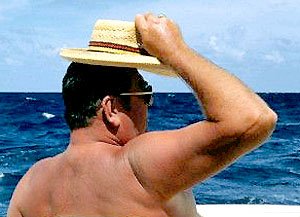
Q:
Not too long ago, I had a hair transplant (using FUE). Things were OK until several months after the transplant. I spent some time having fun in the sun, and it was maybe close to triple digit degrees outdoors. As soon as I got back to my house, I noticed my scalp in the transplanted area had turned white. It looked like the skin on my head had been scorched. But I didn’t think it was a big deal and I kept on using the Minoxidil with Betaderm spray, which my doctor highly recommended.
A few weeks later, the top of my head (which had been grafted) began to peel and the skin fell off (like a sun burn). And there were a few transplanted hairs which fell off as well, with the skin. This really alarmed me. After about eight weeks, the scalp seems to have healed, although there is some redness in places; but, overall, it seems to be OK. But, I’m a bit worried about the condition of my after-playing-in-the-sun scalp. I know it was probably a sun burn, but I just hope my grafts weren’t damaged beyond repair. I’ve done some research on skin consequences of sun burn, but I wonder if the grafts can ever fully recover from the exposure to the ultra-violet rays. I know if my skin becomes more tan, it’s OK. But about my grafts, I’m really concerned about them.
I need answers, doc.
Yours truly,
A beach bum with a hair transplant
A:
Hey beach bum,
Skin and scalp which has been exposed to the sun’s rays for long periods of time damage both native hairs and transplanted hair. The consequences can be especially harmful if a person who has had a hair transplanted is not under an umbrella or is not wearing a hat of some sort. The scalp skin could be damaged that way. It is best to stay out of the sun after a few minutes, at most. For the first six months, hair transplant patients may want to use sunscreen or wear a hat to prevent hair loss and to guard against permanent damage to hair follicles.
For those who don’t like to wear hats or other types of protective head wear ought to guard their hair as if their financial stability depended on it. Make sure your hair density increases to the point in which your hair follicles cover your entire scalp and so the scalp skin is not exposed to the sun’s scorching rays (especially during summer).
I can’t give you a verdict on whether your newly transplanted hair is permanently damaged. I’m sure I don’t have to tell you this, but I’ll say it anyway in case there are people reading this blog who are in a similar situation: from now on, be very careful about your scalp’s sun exposure. And just kick-back and wait a while to see if the damaged hair grows back.
Remember, after hair transplant care is very important, if not crucial to the longevity of your hair restoration results.
Tags: after hair transplant, complications, fue, hair loss, hair transplant surgery, men hair loss, sun exposure
Posted in Bakersfield hair transplant, California hair transplant, hair transplant, men hair restoration, Newport Beach hair transplant, Orange County hair transplant | No Comments »
Tuesday, September 15th, 2009

As with any surgical procedure, you would have to worry about certain side effects or tedious maintenance. We are asked by every potential surgical patient, “When can I go back to work after my hair transplant surgery?”
Downtime doesn’t only apply to the amount of time you would spend away from your office or how soon you can return. This all depends on the type of work that you do, whether or not you can use a hat, how sensitive the issue of your hair transplant is and whether or not you want to keep it a secret.
We have a few follow up dates after the hair transplant surgery in our California Hair Transplant Offices and each must be completed. On the day after surgery, all patients must have a hair wash done in office to best instruct the patient. We make sure to clean the patient as thoroughly as possible without damaging the hair grafts in a professional and comfortable manner. We make sure the patient understands that scabbing and redness must be dealt with as soon as possible.
Patients are most concerned about how they will look the first few days. Redness and swelling are the most common side effect of the surgery and can last 4-5 days after the surgery. Patients can choose to wear a hat to cover the transplanted area from plain site.
On larger hair transplant cases, the swelling may actually progress to the eyebrow area or even the eyelids and under eyes. 5 to 6 days is all it should take for this kind of swelling to go down, generally. The swelling is most always triggered by large (2500 graft surgery) or mega-session (3000+ graft surgery) procedures but is almost undetectable on smaller cases.
The final concern or issue after hair transplant surgery is the visual aspect of the existing hair. Most cases, we trim the hair in both the recipient and donor area (0.5 to 2cm) and it will stay at about that length for 2 to 3 weeks. In about 90% of patients that undergo surgery, the transplant hair will fall out within the first 3 weeks. This means will look like they did before hair transplant surgery. By this point, there should not be any swelling or redness. Staples and/ or sutures are removed in less than 2 weeks after surgery and the transplanted hair follicles will then go into their resting phase until they are ready to grow again.
Tags: after hair restoration surgery, after hair transplant, complications, hair transplant, hair transplant surgery, high grade baldness, Los Angeles Hair Transplant Center, low grade baldness, male patterned hairloss, men hair loss, redness after hair transplant, swelling after hair transplant, us hair restoration
Posted in California hair transplant, hair transplant | No Comments »
Tuesday, September 8th, 2009
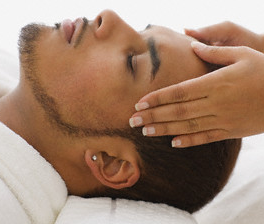
We understand people like to pamper themselves. A patient of ours wrote to us regarding a scalp and body massage. He had his hair transplant surgery in our Encino Surgical Office almost 8 months ago and asked, “Would get a head massage risk loosening the implants?” He also wanted to know if that would help increase circulation to the grafts and improve growth.
Hair that has been transplanted over 3 months ago and is growing normally is considered permanent and cannot be dislodged from your scalp. The main concern is in the first weeks of a hair transplant surgery when the hair is still settling in. Even so, some cases where the hair is removed the active part of the follicle may still remain and a new follicle will grow shortly after. At this point, hair cannot be harmed.
However, there is no proof that a scalp massage to increase scalp circulation is proven to increase the quality of existing or newly transplanted hair. More so, it has also not been proven that lack of blood circulation or oxygenation in scalp will cause hair loss.
Tags: after hair transplant, complications, Encino hair transplant, hair loss treatment, hair transplant surgeon, hair transplant surgery, hair transplatation, male patterned hairloss, men hair loss, scalp massage, scalp massage after hair transplant, us hair restoration
Posted in Uncategorized | No Comments »
Saturday, August 22nd, 2009
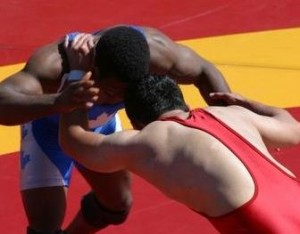
We have a patient who is very physically active. He had a hair transplant procedure and was concerned if he could continue competitive mixed martial arts in the next 3 weeks. “Do you think my head will be okay if I’m doing that? Is it high risk for new transplant hair or donor scars?”
By the time the patient has his mixed martial arts competition it will be over 3 weeks after his hair transplant procedure. At this point hair grafts have already settled and healed and the donor area is closed. The only real concern is putting too much tension on the edges of the healing donor wound. This may cause the wound to widen or stretch.
Most physical activities are fine and should not pose an issue to the donor scar but we do suggest avoiding any sports that may add tension or possibility of stretching until after 1 month from your surgery. The donor scar should be stronger and able to handle any additional stress as you would have normally. However, we do suggest a period of at least 3 months for all aggressive sports just to be safe but that is definitely up to your own personal discretion.
Tags: activity after hair transplant, after hair transplant, donor area, donor scar, martial art, mix martial art, scar stretching, scar widening
Posted in hair transplant, Hair Transplant Procedure, men hair restoration | No Comments »
Tuesday, June 30th, 2009
For patients whom have had hair transplant surgery or for those considering surgery, many questions while arise in regards to the procedure itself. One typical question that comes up has to do with maintenance right after their hair transplant procedure. One patient whose father was caring for him after his surgery asked in a recent email, “When can my son start handling his hair after his hair transplant without any caution?”
It’s always good to be cautious when it comes down to surgical procedures but luckily hair transplant surgery is a relatively minimally invasive procedure which requires very little maintenance. We tell our patients to be most cautious within the first few days (day 1 through 4) of their hair restoration surgery and after that period to continue with their regular washing and handling routine. If you feel the need to conceal the treated areas, it can be easily done by changing your hair style or covering it with a hat or head wrap (bandana).
At this point (day 5), there is really no limitation as to what can be done with your hair except in regards to sun exposure. It is highly recommended to avoided excessive sun exposure to the scalp and treated area for the next 6 months and, if possible or necessary, to try to wear some sort of sun protection (sunscreen or hat).
We schedule to see patients in our offices of US Hair Restoartion in Southern California days 1, 10 and 10 months after hair transplant.
Tags: after hair transplant, care after hair transplant, combing after hair transplant, hair transplant surgery, hair wash, hair wash after hair transplant, LA hair transplant
Posted in after hair transplant, California hair transplant, hair transplant | No Comments »
Monday, June 22nd, 2009
For patients whom have had hair transplant surgery or for those considering surgery, many questions while arise in regards to the procedure itself. One typical question that comes up has to do with maintenance right after their hair transplant procedure. One patient whose father was caring for him after his surgery asked in a recent email, “When can my son start handling his hair after his hair transplant without any caution?”
It’s always good to be cautious when it comes down to surgical procedures but luckily hair transplant surgery is a relatively minimally invasive procedure which requires very little maintenance. We tell our patients to be most cautious within the first few days (day 1 through 4) of their hair restoration surgery and after that period to continue with their regular washing and handling routine. If you feel the need to conceal the treated areas, it can be easily done by changing your hair style or covering it with a hat or head wrap (bandana)
At this point (day 5), there is really no limitation as to what can be done with your hair except in regards to sun exposure. It is highly recommended to avoid excessive sun exposure to the scalp and treated area for the next 6 months and, if possible or necessary, to try to wear some sort of sun protection (sunscreen or hat).
You can read more on what happens after hair transplant surgery in our website.
Tags: after hair transplant, care after hair transplant, combing after hair transplant, hair transplant surgery, hair wash, hair wash after hair transplant, LA hair transplant
Posted in after hair transplant, California hair transplant, hair transplant, men hair restoration | No Comments »
Monday, June 8th, 2009
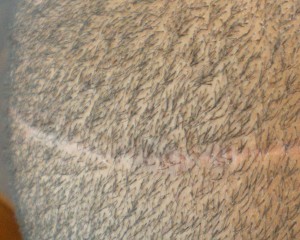 Hair restoration surgery through follicular unit transplantation is the golden standard for hair transplants to date. This procedure is designed to fully recreate a natural looking hairline and add density or restore lost hair caused by male or female pattern baldness. The only concerning factor of this technique is the scar that remains after the procedure is complete. Men especially whom have had hair restoration surgery have wondered and asked how short can their hair really be to avoid seeing or even noticing the scar and if there is a way to avoid such a scar? Hair restoration surgery through follicular unit transplantation is the golden standard for hair transplants to date. This procedure is designed to fully recreate a natural looking hairline and add density or restore lost hair caused by male or female pattern baldness. The only concerning factor of this technique is the scar that remains after the procedure is complete. Men especially whom have had hair restoration surgery have wondered and asked how short can their hair really be to avoid seeing or even noticing the scar and if there is a way to avoid such a scar?
The linear scar that is left after a hair restoration procedure through strip technique is really inevitable but can be made less visible depending on your hair transplant surgeon. Most facilities that do hair transplant practice a technique known as trichophytic closure for their patients. Trichophytic closure is a technique used where hair follicles will penetrate through the donor scar which, in turn, minimizes its visibility and detect ability. This can be compromised if the scar ends up stretching or widening. Another study conducted has shown that BOTOX can be used to prevent further stretching or widening of the donor scar and must be applied by a professional physician for best results.
The length of a person’s hair is really up to the patient or their stylist’s best disclosure. Most donor scars are minimal and undetectable but in most cases anything shorter than a #2 clipper (1/4″ buzz cut) may make the scar visible.
The only other option available to minimize scarring is through a different hair transplant technique called follicular unit extraction (FUE). This technique is done by selectively extracting follicular units and refining them for hair transplantation. The result is undetectable and the downtime is even less than that of follicular unit transplantation through strip technique. This procedure can also be used to fill in existing scars where hair use to grow or the donor scar area. Findings on this type of procedure were originally published when conducted on patients with neurological scar revision.
Tags: after hair transplant, crew cut, donor scar, donor scar revision, donr complications, hair transplant donor scar, linear scar, shaving head, stretched donor scar, strip technique donor scar, trichophytic closure, visible donor scar, wide donor scar
Posted in donor scar, hair transplant | No Comments »
Friday, April 3rd, 2009
We had a patient from a different hair restoration clinic that had a few concerns about his hair transplant results. He underwent hair transplant in September of 2008 and mentions that sometime in November he started trimming his hair avoiding the transplanted area and then started trimming all areas to help him monitor his progress. He also stated that he has curly hair which can make it relatively hard to really notice his growth. He fears that because he never asked how many grafts he had received that maybe he had less done than he had hoped for.
He asks, “Does transplanted hair regrow at different rates?”. Generally, transplanted hair goes through a few changes. First, the transplanted hairs will shed in about 9 out of 10 people and you will probably see some or if any results in about 3 months after your hair transplant surgery. This is the most obvious result for patients who had little to no hair in the first place.
Most patients who already have existing hair don’t usually see or notice results until about 6-8 months after the surgery. The hair is growing but visually it does not compare to the existing hair and can be easily mistaken as a bad hair transplant. Once the transplanted hair becomes long and thick enough you can easily distinguish the results.
We understand the importance of results to our patients but results after hair transplant cannot be rushed. As for a follow up or additional procedure, US Hair Restoration does not recommend having an additional hair transplant procedure within less than 6 months of the initial procedure because many of the grafts may not even be out at that time. With patience and time you will see the results of your transplanted hair in a few months or sooner.
Tags: 4 months after hair transplant, after hair transplant, Dr. Mohebi, hair transplant doctor
Posted in hair transplant, men hair restoration | No Comments »
Saturday, January 31st, 2009
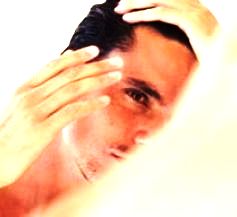 We answer to our patients and other patients who underwent or planning to undergo a hair transplant surgery in our hair restoration blog. Here is one of the question from a patient who has hair transplant around four months ago. Patient is anxious to see growth of his transplanted hair as soon as possible. He stated that he underwent a procedure four months ago and it has been hard to tell the growth of hair. We answer to our patients and other patients who underwent or planning to undergo a hair transplant surgery in our hair restoration blog. Here is one of the question from a patient who has hair transplant around four months ago. Patient is anxious to see growth of his transplanted hair as soon as possible. He stated that he underwent a procedure four months ago and it has been hard to tell the growth of hair.
He continues as follows, “In November at least over 2 months after the surgery I started using a buzzer on all unaffected areas of my head to balance out the length of the shave of the recipient area. I wasn’t totally bald before so eventually, my already existing hair in the front starting getting a little out of balance. I was pretty cautious about shaving the recipient area, so roughly around mid-December I started shaving it all to balance everything out. I also did it so I could monitor the improvement better, as it’s not easy when it’s uneven. It seems like I have more hair than I used to, but it’s still barely half the density of all the surrounding hair on the sides and around the top, not the front, which is approximately half as dense.
Can it be the side effect of the finasteride? But I barely remember the holes being poked in the recipient area when my hair transplant doctor performed the procedure. One thing that concerns me is that I was never told exactly how many grafts were transplanted. It never really worried me until now. When I had a previously replacement at X hair clinic, to be exact, they told me, but then I wasn’t under any strong sedatives so perhaps that’s why I’m concerned.”
Patient asked, “Does transplanted hair regrow at different rates? I know that some has grown in, but to me it’s not enough, as it’s very noticeable that it’s much less dense in the area I expected to get treated the most. Like it doesn’t seem too much improved when compared to before the procedure. To put it frankly, I’m already considering undergoing another transplant procedure, because my expectations were not met.
I must admit that my doctor was very nice, and answered all of my questions. However, I must say that I’m not impressed. This isn’t the first hair transplant procedure I’ve undergone. Actually, it’s the third. I don’t clearly remember the dates involved, like basically how long it took to see a difference, but for some reason I’m expecting to see more of a difference this most recent time around, because this hair restoration procedure involved the largest number of grafts. I’m just hoping that it takes longer for all the transplanted hair to actually kick in, and that it ramps up over time. Basically I’m hoping that seeing any difference doesn’t mean that that’s it.
If you have similar question after hair transplant surgery, don’t panic. The growth of transplanted hair could be very gradual and full result may not be seen before one full year after hair transparent. Of course you need to discuss your concerns with your hair transplant doctor. Transplanted hair generally sheds in 90% of people and you do not see anything for about 3 months after the hair transplant surgery. After the third month you may start seeing growth of most transplanted hair. That is more obvious for the patients who do not have any hair at all. People who already have some hair should not be able to see much before 6-8 months from the time of their surgery when transplanted hair is long and thick enough to be distinguished.
I understand that you are anxious to see the final result as soon as possible, but you cannot rush the growth of grafts. I do not perform nor recommend doing a second procedure before 6 months from the previous hair transplant because many of the grafts are not even out at that time. Be patient and you will see your transplanted hair growing in a few months.
Tags: after hair transplant, hair loss clinic, hair transplant, hair transplant doctor, hair transplant surgeon
Posted in men hair restoration | No Comments »
|
|







